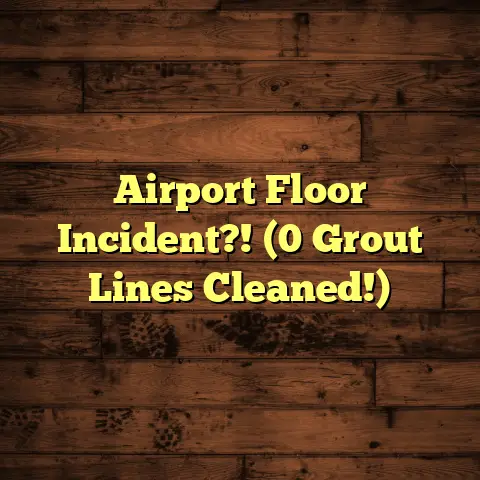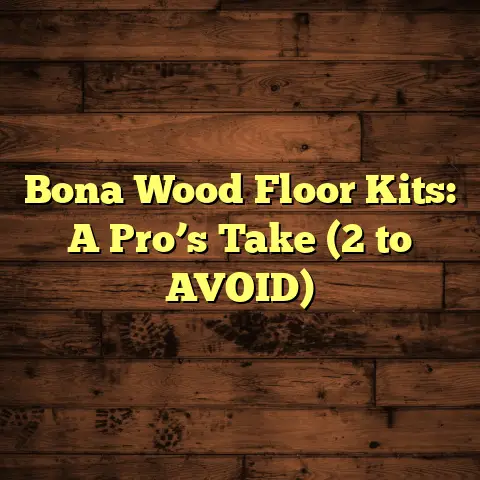Damp Floor? Diagnosing Moisture (1 Hour Fix!)
Ever walk into a room and get that slight chill? Not the spooky kind, but the kind that makes you wonder if you’ve accidentally stepped into a swamp? Yeah, that’s the universe subtly reminding you that what goes up must come down – and sometimes, that “down” is excess moisture creeping into your floors.
I remember one time, I got called out to a job. The homeowner swore their living room was haunted. Turns out, it was just a leaky pipe under the slab making the floor perpetually damp. Ghostly, right?
But seriously, damp floors are no joke. They can be a sign of serious underlying issues. And that’s what we’re going to tackle today. Let’s get to it!
Section 1: Understanding the Problem
So, what exactly is a damp floor? It’s more than just a spill you forgot to wipe up. It’s persistent moisture that’s affecting your flooring.
Think of it like this: your floor is supposed to be dry. When it’s consistently damp, you’ve got a problem.
Common Causes of Damp Floors:
- Environmental Factors: High humidity, condensation, and even heavy rainfall can contribute.
- Plumbing Issues: Leaky pipes, dripping faucets, and even a running toilet can be culprits.
- Structural Problems: Cracks in the foundation, poor drainage, and inadequate ventilation can allow moisture to seep in.
Now, different flooring types react differently to moisture.
- Wood: Wood is like a sponge. It absorbs moisture, leading to warping, cupping, and even rot.
- Tile: Tile itself is waterproof, but the grout lines aren’t. Moisture can seep through the grout, leading to mold and mildew.
- Carpet: Carpet is a moisture magnet. It traps moisture, creating a breeding ground for mold and bacteria.
- Laminate: Laminate flooring is also susceptible to moisture damage. The core of laminate flooring is often made of wood composite. This can swell and warp when exposed to moisture.
The key takeaway here is that you need to diagnose the source. Slapping a rug over a damp spot is like putting a bandage on a broken leg – it doesn’t fix the underlying problem.
Section 2: Signs of Moisture Problems
Okay, so how do you know if you have a damp floor? Here are some telltale signs:
- Discoloration: Look for dark spots, stains, or changes in color on your flooring. On wood, this might look like a graying or blackening. On carpet, it could be a yellowish or brownish stain.
- Mold Growth: Mold loves moisture. Check for visible mold growth, especially in corners, along baseboards, and under furniture. It can appear as black, green, or white fuzzy patches.
- Musty Odors: That funky, stale smell? That’s often a sign of mold or mildew growth. If you smell it, you likely have a moisture problem.
- Warping: Wood floors can warp, cup, or buckle when exposed to moisture. Tile can crack or become loose. Laminate can swell and separate.
Visual Examples:
- Imagine a hardwood floor with dark, circular stains near the baseboards. That’s a classic sign of water damage.
- Picture a carpet with a fuzzy, greenish patch in the corner of a room. That’s mold, plain and simple.
- Think of tile grout that’s turned black and slimy. That’s mildew thriving in a damp environment.
Health Risks:
Prolonged exposure to moisture and mold can lead to some serious health issues. According to the EPA, mold exposure can cause:
- Respiratory problems (coughing, wheezing, difficulty breathing)
- Allergic reactions (skin rashes, itchy eyes, runny nose)
- Asthma attacks
- Irritation of the eyes, nose, and throat
Don’t ignore those damp floors. Your health could depend on it.
Section 3: Diagnosing the Source of Moisture
Alright, detective time! Let’s figure out where that moisture is coming from.
Step 1: Visual Inspection
- Basements: Basements are notorious for moisture problems. Check for cracks in the foundation walls, water stains, and signs of efflorescence (a white, powdery deposit that indicates moisture seepage).
- Bathrooms: Bathrooms are another prime suspect. Inspect around the toilet, shower, and sink for leaks. Check the grout lines for cracks and discoloration.
- Kitchens: Look under the sink, around the dishwasher, and behind the refrigerator. These areas are prone to leaks.
- Around Windows and Doors: Check for water stains or discoloration around window and door frames. This could indicate a leak in the sealant.
Step 2: Assessing Humidity Levels
Grab a hygrometer (you can find them at most hardware stores). A hygrometer measures the relative humidity in the air.
- Ideal Humidity: The ideal humidity level in your home is between 30% and 50%.
- High Humidity: If your hygrometer reads above 60%, you have a humidity problem.
- Interpreting Readings: High humidity can be caused by poor ventilation, leaks, or even just excessive moisture from cooking or showering.
Step 3: Checking for Plumbing Issues
Grab your toolbox and get ready to play plumber (sort of).
- Toilet Test: Add a few drops of food coloring to the toilet tank. If the color appears in the bowl without flushing, you have a leak.
- Faucet Inspection: Check all faucets for drips. Even a small drip can add up to gallons of wasted water over time.
- Under-Sink Inspection: Look for leaks around the pipes and connections under your sinks.
- Appliance Connections: Check the hoses and connections to your washing machine, dishwasher, and refrigerator.
Step 4: Foundation and Drainage Inspection
Time to head outside and play landscaper.
- Grading: Make sure the ground slopes away from your foundation. This will help prevent water from pooling around your home.
- Gutters and Downspouts: Ensure your gutters are clean and your downspouts are directing water away from your foundation.
- Cracks in Foundation: Inspect your foundation for cracks. Even small cracks can allow water to seep into your basement.
Section 4: Quick Fixes for Damp Floors
Okay, you’ve found the source of the moisture. Now what? Here are some quick fixes you can implement in about an hour:
Solution 1: Sealing Cracks and Gaps
- What to Do: Use caulk or sealant to seal any cracks or gaps in your floors, walls, or around windows and doors.
- Why It Works: This prevents moisture from seeping in through these openings.
- Pro Tip: Choose a sealant that’s specifically designed for wet environments.
Solution 2: Utilizing Dehumidifiers
- What to Do: Place a dehumidifier in the affected area to reduce humidity levels.
- Why It Works: Dehumidifiers remove moisture from the air, helping to dry out your floors.
- Pro Tip: Choose a dehumidifier that’s the right size for your space. A small dehumidifier won’t be effective in a large, damp basement.
Solution 3: Immediate Clean-Up
- What to Do: If you’ve experienced a minor flooding incident, act quickly. Use towels, mops, and fans to dry up the water as soon as possible.
- Why It Works: The faster you dry up the water, the less damage it will cause.
- Pro Tip: Open windows and doors to improve ventilation and speed up the drying process.
Solution 4: Temporary Flooring Solutions
- What to Do: If you have a small area of damp flooring that needs more extensive repairs, consider using a temporary flooring solution like a waterproof mat or rug.
- Why It Works: This will protect the area from further damage while you plan for repairs.
- Pro Tip: Make sure the temporary flooring is breathable to allow any remaining moisture to evaporate.
Section 5: Long-Term Solutions and Prevention
Quick fixes are great, but they’re not a substitute for long-term solutions. You need to address the underlying issues that caused the damp floor in the first place.
Long-Term Solutions:
- Fix Leaks: Repair any plumbing leaks promptly. Don’t let a dripping faucet turn into a major water damage problem.
- Improve Ventilation: Install exhaust fans in bathrooms and kitchens to remove moisture. Make sure your attic is properly ventilated to prevent condensation.
- Repair Foundation Cracks: Hire a professional to repair any cracks in your foundation. This will prevent water from seeping into your basement.
- Improve Drainage: Regrade your yard to ensure proper drainage. Install French drains to redirect water away from your foundation.
Preventive Measures:
- Regular Maintenance: Inspect your plumbing, gutters, and foundation regularly for any signs of problems.
- Moisture Barriers: Install moisture barriers under your flooring to prevent moisture from seeping up from the subfloor.
- Proper Ventilation: Ensure your home is properly ventilated to prevent moisture buildup.
- Control Humidity: Use dehumidifiers or air conditioners to control humidity levels in your home.
When to Call a Professional:
Sometimes, the moisture problem is too big to handle on your own. Here are some signs that it’s time to call in a professional:
- Extensive Water Damage: If you have widespread water damage, it’s best to call a professional water damage restoration company.
- Mold Infestation: If you have a large mold infestation, it’s important to call a mold remediation specialist.
- Structural Problems: If you suspect that your damp floor is caused by structural problems, you should consult with a structural engineer.
Conclusion: The Importance of Timely Action
Damp floors are a common problem, but they don’t have to be a permanent one. By understanding the causes of moisture accumulation, identifying the signs of moisture problems, and taking prompt action, you can protect your flooring and your health.
Remember, quick fixes can provide temporary relief, but long-term solutions are essential for preventing future problems. Don’t ignore those damp floors. Take proactive steps to maintain your flooring and home health.
So, next time you feel that slight chill under your feet, don’t just shrug it off. Investigate! Your floors (and your health) will thank you.





